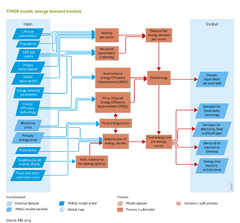Energy demand/Policy issues: Difference between revisions
Jump to navigation
Jump to search
No edit summary |
Oostenrijr (talk | contribs) No edit summary |
||
| Line 9: | Line 9: | ||
* Enforced market shares of fuel types. Such an analysis could, for instance, provide insight into the implications in the model of increasing the use of biofuels, electricity or hydrogen ([[Van Ruijven et al., 2007]]). | * Enforced market shares of fuel types. Such an analysis could, for instance, provide insight into the implications in the model of increasing the use of biofuels, electricity or hydrogen ([[Van Ruijven et al., 2007]]). | ||
The PBL study [[Resource | The PBL study [[EU Resource efficiency (2011) project|Resource Efficiency]] ([[Van den Berg et al., 2011]]) provides an example of how TIMER can be used to explore the impact of radically improving energy efficiency. The study included an accelerated trend to best available technologies in iron and steel production and other industries, most efficient passenger vehicles and aircraft, a moderate shift from aircraft to high-speed trains, and building highly efficient housing (mostly insulation measures). The study also assumed that newly installed power plants will be based on the best available technologies. The measures in this global energy efficiency scenario will considerably reduce energy use than under the baseline scenario. Primary energy consumption will be reduced by about 30% by 2050. | ||
}} | }} | ||
Revision as of 19:11, 29 April 2016
Parts of Energy demand/Policy issues
| Component is implemented in: |
|
| Related IMAGE components |
| Projects/Applications |
| Key publications |
| References |
